Page 326 of 538
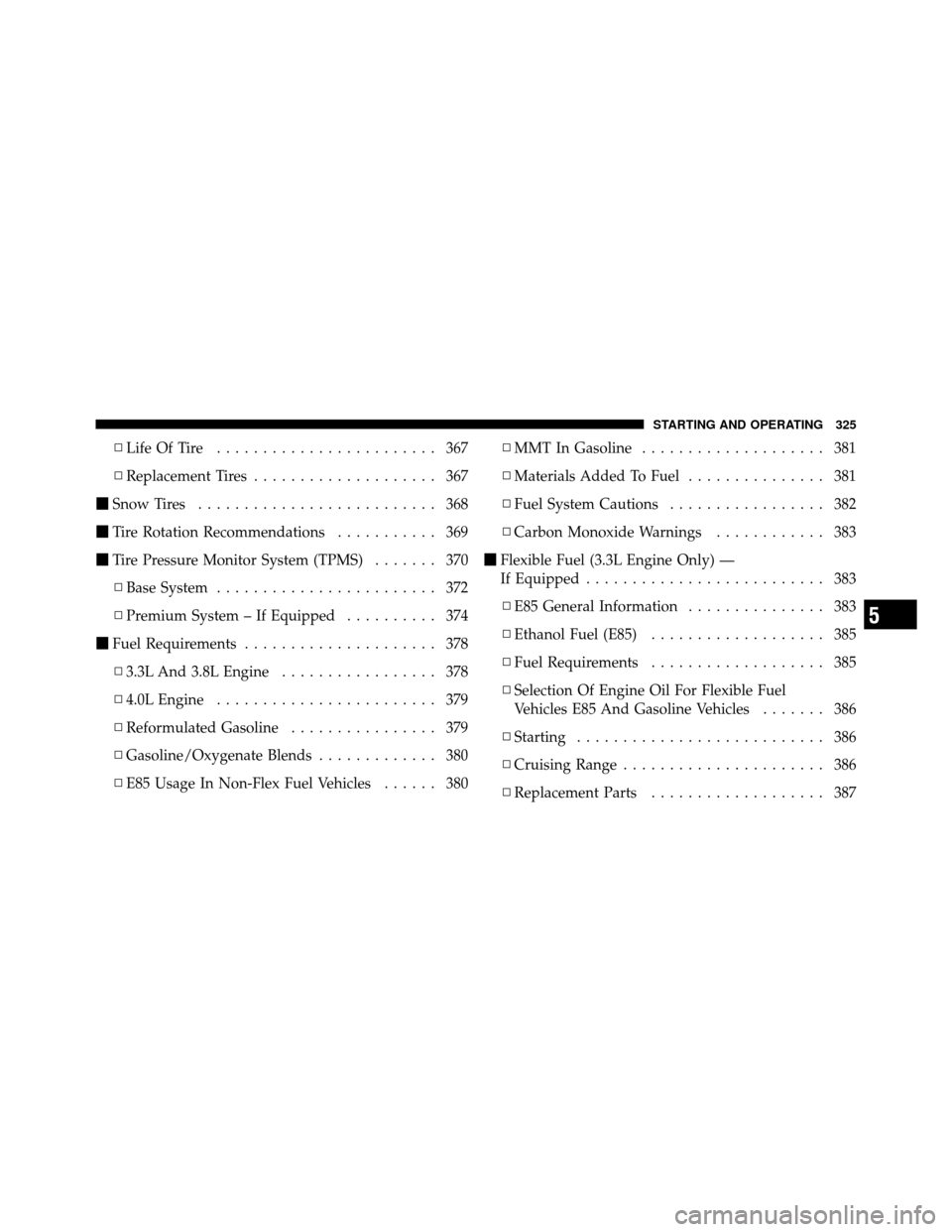
▫Life Of Tire ........................ 367
▫ Replacement Tires .................... 367
� Snow Tires .......................... 368
� Tire Rotation Recommendations ........... 369
� Tire Pressure Monitor System (TPMS) ....... 370
▫ Base System ........................ 372
▫ Premium System – If Equipped .......... 374
� Fuel Requirements ..................... 378
▫ 3.3L And 3.8L Engine ................. 378
▫ 4.0L Engine ........................ 379
▫ Reformulated Gasoline ................ 379
▫ Gasoline/Oxygenate Blends ............. 380
▫ E85 Usage In Non-Flex Fuel Vehicles ...... 380▫
MMT In Gasoline .................... 381
▫ Materials Added To Fuel ............... 381
▫ Fuel System Cautions ................. 382
▫ Carbon Monoxide Warnings ............ 383
� Flexible Fuel (3.3L Engine Only) —
If Equipped .......................... 383
▫ E85 General Information ............... 383
▫ Ethanol Fuel (E85) ................... 385
▫ Fuel Requirements ................... 385
▫ Selection Of Engine Oil For Flexible Fuel
Vehicles E85 And Gasoline Vehicles ....... 386
▫ Starting ........................... 386
▫ Cruising Range ...................... 386
▫ Replacement Parts ................... 387
5
STARTING AND OPERATING 325
Page 341 of 538
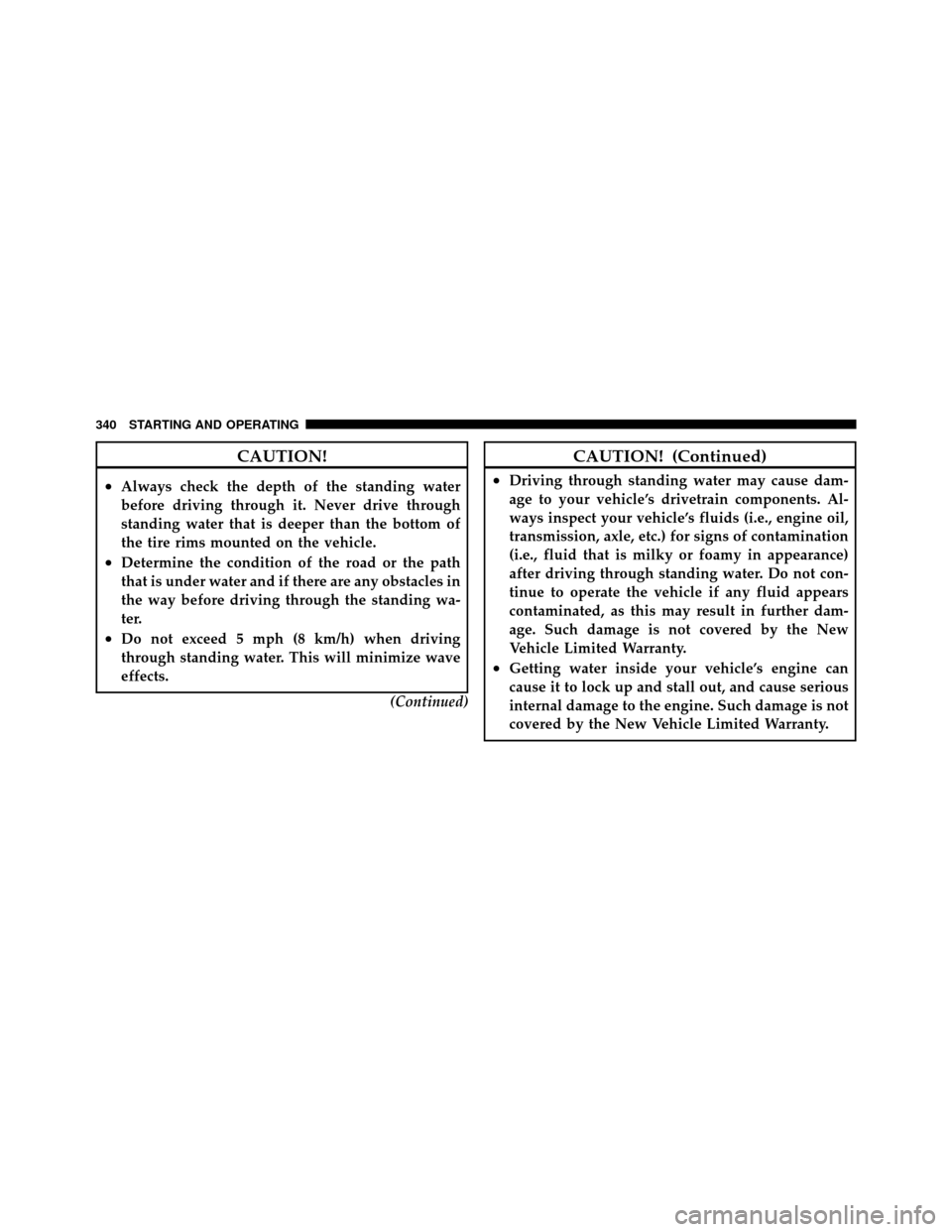
CAUTION!
•Always check the depth of the standing water
before driving through it. Never drive through
standing water that is deeper than the bottom of
the tire rims mounted on the vehicle.
•Determine the condition of the road or the path
that is under water and if there are any obstacles in
the way before driving through the standing wa-
ter.
•Do not exceed 5 mph (8 km/h) when driving
through standing water. This will minimize wave
effects.(Continued)
CAUTION! (Continued)
•Driving through standing water may cause dam-
age to your vehicle’s drivetrain components. Al-
ways inspect your vehicle’s fluids (i.e., engine oil,
transmission, axle, etc.) for signs of contamination
(i.e., fluid that is milky or foamy in appearance)
after driving through standing water. Do not con-
tinue to operate the vehicle if any fluid appears
contaminated, as this may result in further dam-
age. Such damage is not covered by the New
Vehicle Limited Warranty.
•Getting water inside your vehicle’s engine can
cause it to lock up and stall out, and cause serious
internal damage to the engine. Such damage is not
covered by the New Vehicle Limited Warranty.
340 STARTING AND OPERATING
Page 381 of 538
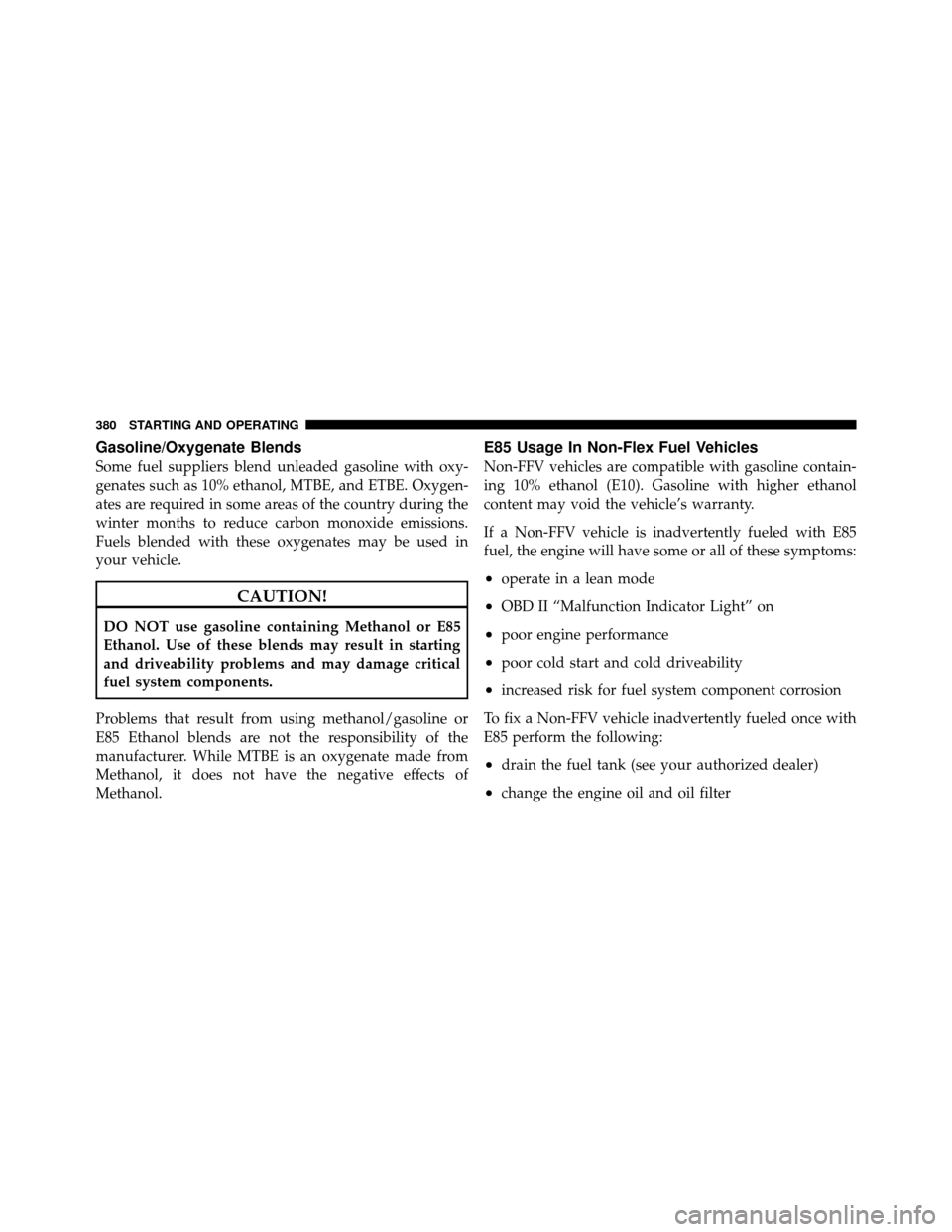
Gasoline/Oxygenate Blends
Some fuel suppliers blend unleaded gasoline with oxy-
genates such as 10% ethanol, MTBE, and ETBE. Oxygen-
ates are required in some areas of the country during the
winter months to reduce carbon monoxide emissions.
Fuels blended with these oxygenates may be used in
your vehicle.
CAUTION!
DO NOT use gasoline containing Methanol or E85
Ethanol. Use of these blends may result in starting
and driveability problems and may damage critical
fuel system components.
Problems that result from using methanol/gasoline or
E85 Ethanol blends are not the responsibility of the
manufacturer. While MTBE is an oxygenate made from
Methanol, it does not have the negative effects of
Methanol.
E85 Usage In Non-Flex Fuel Vehicles
Non-FFV vehicles are compatible with gasoline contain-
ing 10% ethanol (E10). Gasoline with higher ethanol
content may void the vehicle’s warranty.
If a Non-FFV vehicle is inadvertently fueled with E85
fuel, the engine will have some or all of these symptoms:
•operate in a lean mode
•OBD II “Malfunction Indicator Light” on
•poor engine performance
•poor cold start and cold driveability
•increased risk for fuel system component corrosion
To fix a Non-FFV vehicle inadvertently fueled once with
E85 perform the following:
•drain the fuel tank (see your authorized dealer)
•change the engine oil and oil filter
380 STARTING AND OPERATING
Page 387 of 538
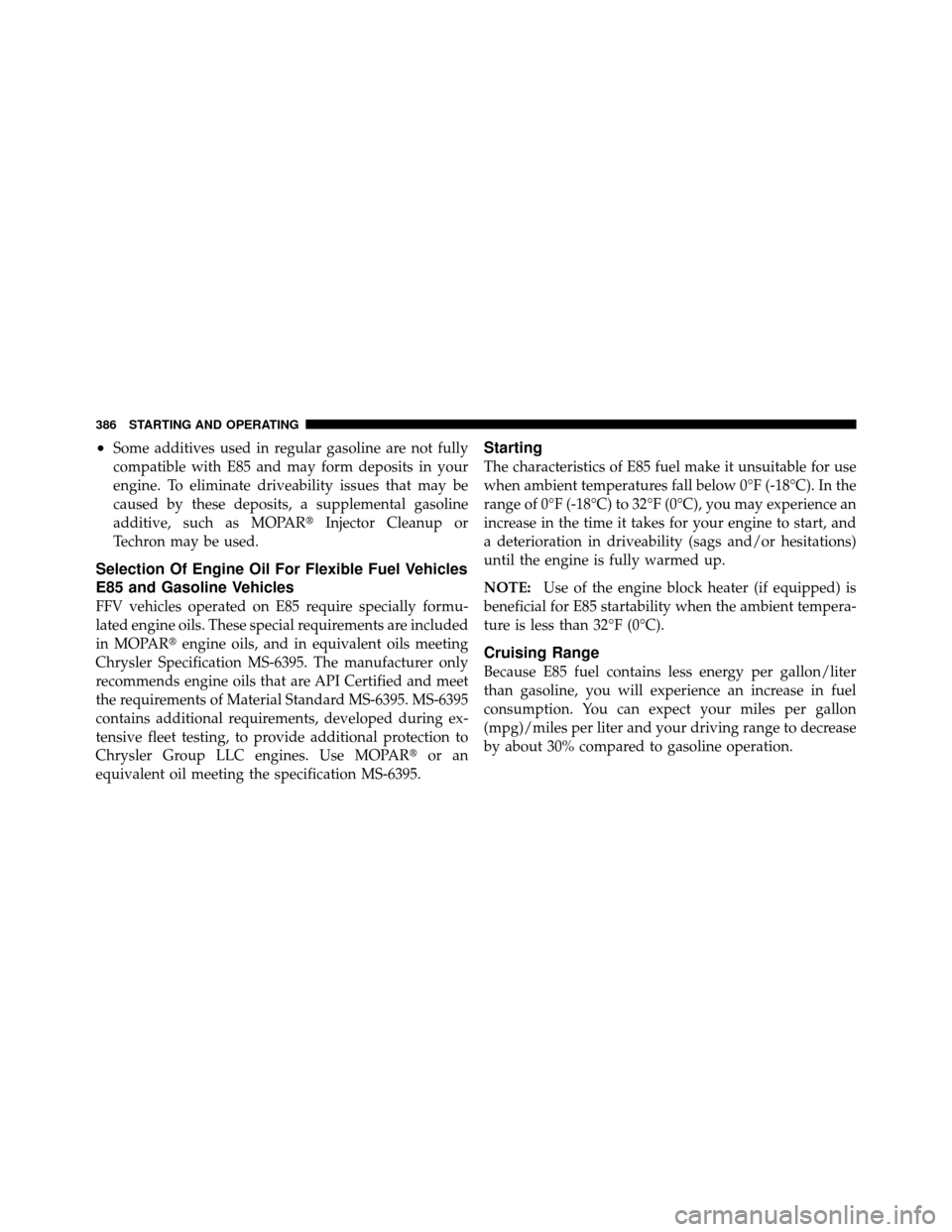
•Some additives used in regular gasoline are not fully
compatible with E85 and may form deposits in your
engine. To eliminate driveability issues that may be
caused by these deposits, a supplemental gasoline
additive, such as MOPAR�Injector Cleanup or
Techron may be used.
Selection Of Engine Oil For Flexible Fuel Vehicles
E85 and Gasoline Vehicles
FFV vehicles operated on E85 require specially formu-
lated engine oils. These special requirements are included
in MOPAR� engine oils, and in equivalent oils meeting
Chrysler Specification MS-6395. The manufacturer only
recommends engine oils that are API Certified and meet
the requirements of Material Standard MS-6395. MS-6395
contains additional requirements, developed during ex-
tensive fleet testing, to provide additional protection to
Chrysler Group LLC engines. Use MOPAR� or an
equivalent oil meeting the specification MS-6395.
Starting
The characteristics of E85 fuel make it unsuitable for use
when ambient temperatures fall below 0°F (-18°C). In the
range of 0°F (-18°C) to 32°F (0°C), you may experience an
increase in the time it takes for your engine to start, and
a deterioration in driveability (sags and/or hesitations)
until the engine is fully warmed up.
NOTE: Use of the engine block heater (if equipped) is
beneficial for E85 startability when the ambient tempera-
ture is less than 32°F (0°C).
Cruising Range
Because E85 fuel contains less energy per gallon/liter
than gasoline, you will experience an increase in fuel
consumption. You can expect your miles per gallon
(mpg)/miles per liter and your driving range to decrease
by about 30% compared to gasoline operation.
386 STARTING AND OPERATING
Page 434 of 538
MAINTAINING YOUR VEHICLE
CONTENTS
�Engine Compartment — 3.3/3.8L .......... 435
� Engine Compartment — 4.0L ............. 436
� Onboard Diagnostic System — OBD II ...... 437
▫ Loose Fuel Filler Cap Message ........... 437
� Emissions Inspection And Maintenance
Programs ............................ 438
� Replacement Parts ..................... 440
� Dealer Service ........................ 440
� Maintenance Procedures ................. 440 ▫
Engine Oil ......................... 441
▫ Engine Oil Filter ..................... 444
▫ Engine Air Cleaner Filter ............... 444
▫ Exhaust System ..................... 445
▫ Maintenance-Free Battery .............. 447
▫ Air Conditioner Maintenance ............ 448
▫ Body Lubrication .................... 451
▫ Windshield Wiper Blades ............... 451
▫ Cooling System ..................... 453
7
Page 436 of 538
ENGINE COMPARTMENT — 3.3/3.8L
1 — Air Cleaner Filter7 — Engine Oil Fill
2 — Automatic Transmission Dipstick (3.3L Only) 8 — Engine Oil Dipstick
3 — Brake Fluid Reservoir 9 — Coolant Pressure Cap
4 — Battery 10 — Washer Fluid Reservoir
5 — Totally Integrated Power Module 11 — Power Steering Fluid Reservoir
6 — Engine Coolant Reservoir
7
MAINTAINING YOUR VEHICLE 435
Page 437 of 538
ENGINE COMPARTMENT — 4.0L
1 — Power Steering Fluid Reservoir7 — Engine Oil Dipstick
2 — Air Cleaner Filter 8 — Engine Oil Fill
3 — Brake Fluid Reservoir 9 — Coolant Pressure Cap
4 — Battery 10 — Washer Fluid Reservoir
5 — Totally Integrated Power Module
6 — Engine Coolant Reservoir
436 MAINTAINING YOUR VEHICLE
Page 442 of 538
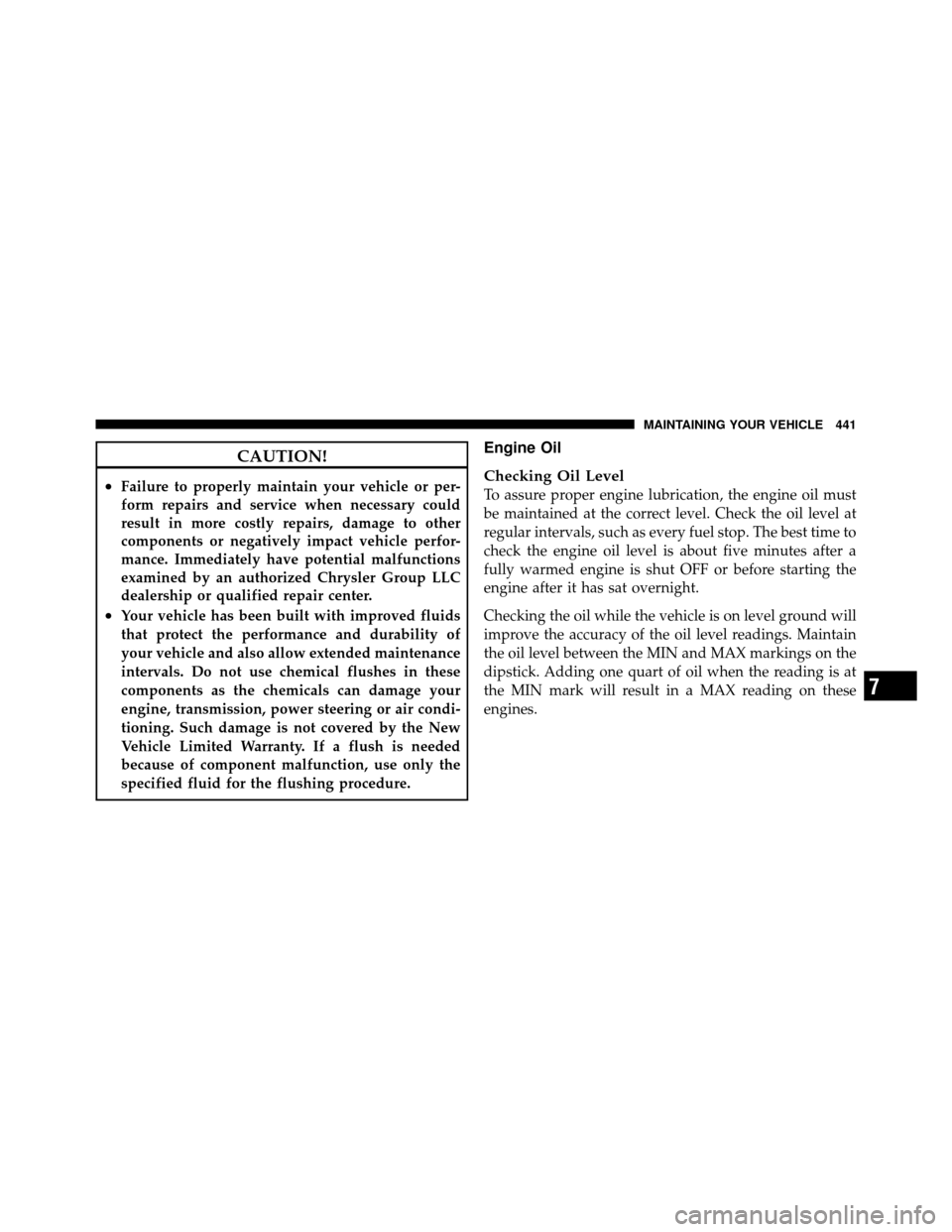
CAUTION!
•Failure to properly maintain your vehicle or per-
form repairs and service when necessary could
result in more costly repairs, damage to other
components or negatively impact vehicle perfor-
mance. Immediately have potential malfunctions
examined by an authorized Chrysler Group LLC
dealership or qualified repair center.
•Your vehicle has been built with improved fluids
that protect the performance and durability of
your vehicle and also allow extended maintenance
intervals. Do not use chemical flushes in these
components as the chemicals can damage your
engine, transmission, power steering or air condi-
tioning. Such damage is not covered by the New
Vehicle Limited Warranty. If a flush is needed
because of component malfunction, use only the
specified fluid for the flushing procedure.
Engine Oil
Checking Oil Level
To assure proper engine lubrication, the engine oil must
be maintained at the correct level. Check the oil level at
regular intervals, such as every fuel stop. The best time to
check the engine oil level is about five minutes after a
fully warmed engine is shut OFF or before starting the
engine after it has sat overnight.
Checking the oil while the vehicle is on level ground will
improve the accuracy of the oil level readings. Maintain
the oil level between the MIN and MAX markings on the
dipstick. Adding one quart of oil when the reading is at
the MIN mark will result in a MAX reading on these
engines.
7
MAINTAINING YOUR VEHICLE 441